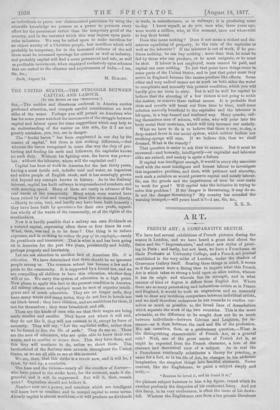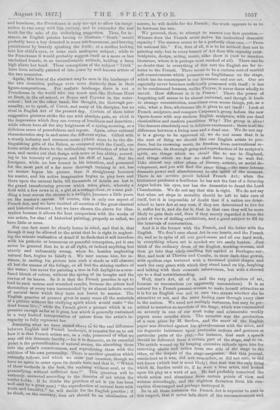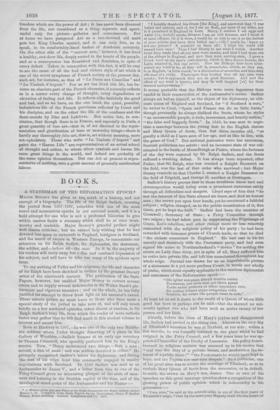ART.
FRENCH ART: A COMPARATIVE SKETCH.
WE have had several exhibitions of French pictures during the season in London, and we have heard a great deal about the- Salon and the "Impressionists," and other new styles of paint- ing in Paris ; and lastly, but not least, we have a Frenchman as Slade Professor at University College, and a French art journal established in the very midst of London, under the shadow of Grosvenor Gallery itself. Bearing these things in mind, it seems as if the present were a fitting time to inquire what this French, Art is which takes so strong a hold upon an alien nation, whence it has its origin and wherein lies its strength, and in what manner of kind or degree it differs from English Art, Where there are so many painstaking and industrious artists as in France. and England, it would be both an ungracious and an unseemly task to draw any invidious comparison between individual artists, and we shall therefore endeavour in our remarks to confine our- selves as much as possible to the broad lines of demarkation. which separate the work of the two countries. This is the more• advisable, as the difference to be sought does not lie so much between individuals—between G6rome and Leighton, for in- stance—as it does between the rank and file of the profession. We ask ourselves, then, as a preliminary question,—What is the distinguishing characteristic of French Art, as a genera!' rule ? Well, one of the great marks of French Art is, as. might be expected from the French character, a love of the abstract and theoretical view of a subject. As in real life a Frenchman continually substitutes a theory for practice, a name for a fact, so in his life of Art, he changes in his alchemic imagination -the simplest things into fanciful abstracts. Never content, like the Englishman, to paint a subject simply and truly,— "Because he loved it, and ho found it sop the plainest subject becomes to him a lay figure, round which he swathes profusely the draperies of his exuberant fancy. And yet this fancy, in its very exuberance, is often the cause of his down- fall. Whereas the Englishman errs from a too prosaic literalness
and heaviness, the Frenchman is only too apt to allow his imagi- nation to run away with him entirely, and to surrender the real truth for the sake of the underlying suggestion. Thus, for in- stance, an English painter having to illustrate " Truth" would probably have a boy detected in some misdemeanour, and braving punishment by bravely speaking the truth ; or a mother looking into her child's eyes, or some such analogous subject ; while to the Frenchman it would probably suggest itself as a more or less unclothed female, in an uncomfortable attitude, holding a lamp high above her head. These conceptions of the subject " Truth " have been actually painted of late years by well-known artists of the two countries.
Again, this love of the abstract may be seen in the landscape of the two countries, perhaps even more distinctly than in their figure-compositions. For realistic landscape there is not a Frenchman in the world who can touch men like Ilolman Hunt or Brett, in the oil school, or Boyce and Poynter in the water- colour ; but on the other hand, the thought, the thorough per- sonality, so to speak, of Corot, and many of his disciples, has no rival in English Art of the present day. Certain of these latter suggestive pictures strike the eye with absolute pain, so vivid is the impression which they can convey of loneliness and desertion ; while others have all the airy brightness of a spring morning, or a delicious sense of peacefulness and repose. Again, other national characteristics step in and cause the different styles. Gifted with a sturdy industry and common-sense (which seem to be the dis- tinguishing gifts of the Briton, as compared with the Gaul), our home artist sits down to the unflinching reproduction of what he sees, and carries out that design with more or less ability, accord- ing to his honesty of purpose and his skill of hand. But the foreigner, while no less honest in his intention, and possessed for the most part of a far more thorough training in art, has no sooner begun his picture than it straightway becomes his master, and his active imagination begins to play hero and there upon the natural facts, till thousands of details are lost in the grand transforming process which takes place, whereby a field with a few cows in it, a girl at a cottage-door, or a man pad- dling a boat across the stream in a twilight, becomes a little poem on the master's canvas. Of course, this is only one aspect of French Art, and we have omitted all mention of the great classical and historical element ; but we have chosen the above for illus- tration because it allows the best comparison with the works of our artists, for alas! of historical painting, properly so called, we have little or none.
But one fact must be clearly borne in mind, and that is, that though it may be allowed to the artist that he is right in neglect- ing the minute realisation of detail if he finds that it will interfere with his pathetic or humorous or peaceful conception, yet it can never be granted that he is at all right, or indeed anything but utterly and unbearably wrong, when he, besides neglecting natural fact, begins to falsify it. We may excuse him, for in- stance, in casting his picture into such a shade as will obscure all but the masses of the foliage, or all but the shining surface of the water ; but never for painting a tree in full daylight as a com- fused blotch of colour, without the spring of its boughs and the curves of its leaves. So it is that the French practice is apt to lead to such untrue and wretched results, because the artists find themselves at every turn incommoded by an almost infinite series of natural facts which they have not learnt to master. The English practice at present gives in many cases all the materials of a picture without the vivifying spirit which would make " the dead bones live ;" while the French gives a picture which is ex- pressive enough as far as it goes, but which is generally restrained to a very limited interpretation of nature from the artist's in- capacity to fully represent her.
Assuming what we have stated above to be the real difference between English and French landscape, it remains for us to ask how it is that French artists aro, as a rule, possessed of what we may call this dramatic faoulty,—for it is dramatic, as its essential point is the personification of natural scenes, the absorbing them into the artist's consciousness, and reproducing them with the addition of his own personality. There is another question which naturally follows, and which we must just mention, though we have no space to enter upon its details here, and that is, " Which of these methods is the best, the realising without soul, or the personifying without sufficient data?" This question will be variously, answered according to the theories of art which the reader holds. If he thinks the province of art is (as has been well said by a great man) " the reproduction of natural facts with truth and humility," he will decide for the English practice ; if he think, on the contrary, that art should be an idealisation of nature, he will decide for the French ; the truth appears to us to lie between the two.
We proceed, then, to attempt to answer our first question,— Whence does the French artist derive his undoubted dramatic capacity ? The answer seems to be a perfectly clear one,—" From his national life." For, first of all, it is to be noticed that not in painting only, but in every branch of Art does this capacity exist. Sculpture, design, acting, music, alike show it (not to mention literature, where it is perhaps most marked of all). There can be no doubt that in everything of this sort the English are far in- ferior to the French. There seems to be a curious sort of morbid self-consciousness which possesses an Englishman on the stage, which has its counterpart in our literature and our art. Our art especially never becomes sufficiently possessed with itself ; it has to be condemned because, unlike Phryne, it never dares wholly to unveil. How different is it in France ! There the power of forgetting self seems to be almost universal, and though it leads
to strange eccentricities, sometimes even worse things, yet, as a rule, what a free, wholesome life it gives to art itself ! Look at French sculpture, and compare Carpeaux's group before the new Opera-house with any modern English sculpture, with our dead classicalities and modern puerilities. Why ! The group is alive The dancers absolutely reel in delirious excitement ; there is all the difference between a living man and a dead one. We do not say it is a group to be approved of, we do not mean that it is the sort of thing we should like our English artists to pro- duce, but its crowning merit, its freedom from conventional re- presentation, its thorough grasp and reproduction of its sculptor's spirit, are things which we should like to see in England, and things which we fear we shall have long to wait for. Take almost any other phase of literary, artistic, or social de- velopment, and you will find the same thing,—the same intense. dramatic power and abandonment to-the spirit of the moment. There is no arriere pewee behind French Art; when the litterateur produces a feuilleton he has not the fear of a Saturday Argus before his eyes, nor has the dramatist to dread the Lord Chamberlain. We do not say that this is right. We do not say that when art steps in morality should be left to take care of itself, but it is impossible to doubt that if a nation are deter- mined to have Art at any cost, if they are determined to live for it, suffer for it, and die for it, that iu that case they will be more likely to gain their end, than if they merely regarded it from the point of view of shilling exhibitions, and a good subject to fill up the intervals of conversation.
And it is the former with the French, and the latter with the English. We don't care about Art in our hearts, and the French do, and so in spite of all our good-sense and all our hard work, in everything where art is needed we are easily beaten. Just think of the ordinary dress of an English working-woman, and then go into that vilely-smelling fish market at Boulogue-sur- Mer, and look at Therese and Coralie, in their dark-blue gowns, with spotless .caps tortured with a thousand quaint shapes, and mark the easy grace with which they stand hand on hip, laughing and talking with their comrade saleswomen, but with a shrewd eye to a deal notwithstanding. Well, that's Art, all of it, and the very perfection of art, because so unconscious (or apparently unconscious). It is as natural for a French peasant-woman to make herself attractive as it is for an English one not to care two straws whether she be attractive or not, and the seine feeling runs through every class in the nation. We need not multiply instances, but may be per- mitted to mention an anecdote of the Stage, which was commented, on severely in one of our most noisy and aristocratic weekly papers seine months since. The occasion was the production of a new piece by M. Sardou, and the sneer of the English paper was directed against his querulousness with the actor, and his dogmatic insistence upon particular actions and gestures at particular parts of the play,—for instance, that such a speech should be delivered from a certain part of the stage, anal so on. The article wound up by heaping excessive ridicule upon him for removing chairs and tables from one side of the stage to the other, to the despair of the stage-carpenter. But this journal, omniscient as it was, did not remember, or did not care, or did not know (which last is most likely) that that was the only thing which M. Sardou could do, if he were a true artist, and looked upon his play as a work of art. He had probably conceived the whole action and situations from certain points of view and written accordingly, and the slightest deviation from his con- ception disarranged and perhaps destroyed it.
So in all these instances the French Art is superior to ours in this respect, that it never falls short of the unconsciousness and freedom which are the power of Art ; it has never been divorced from the life, nor considered as a thing separate and apart,
useful only for picture - galleries and connoisseurs. But at home we have pampered Art as a too-devoted old maid pets her King Charles spaniel, and it can only live, so to speak, in its comfortably-lined basket of Academic notoriety. On the other side of the " narrow seas," however, it has lived a healthy, out-door life, deeply rooted in the hearts of the people, and as a consequence has flourished and flourishes, in spite of every defect. Taken in connection with this fact, it will be easy to see the cause of all the bad and vicious style of art which is one of the worst symptoms of French society at the present day, such art, for instance, as that of "La Dame aux Camellias" and " La Timbale d'Argent." For as art has lived this life, has be- come an absolute part of the French character, it naturally reflects as in a mirror every change of thought, every degradation or elevation of feeling and life. It reflects alike faithfully the good and bad, and so we have, on the one hand, the quiet, peaceful, industrious life of the French provinces reflected by Corot and his disciples, and on the other the life of the coulisses and the demi-monde by Diaz and Lefebvre. But notice this, in con- 'elusion, that though there is in France, and especially in Paris, a great quantity of base art—that is, of art directed to the repre- sentation and glorification of base or unworthy things—there is hardly any thoroughly false art, that is, art without meaning, more art-upholstery. Those who write "La Timbale d'Argent" and paint the "Harem Life" are representatives of an actual school of thought and action, to whom silver cymbals and harem life seem great things in the world, and indeed are probably of the same opinion themselves. But our Art at present is repre- sentative of nothing, save a great amount of generally misdirected labour.




































 Previous page
Previous page